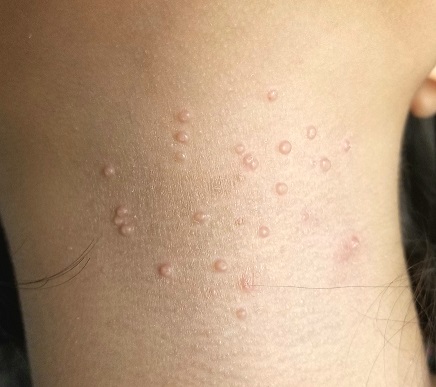A 13-year-old girl is referred to dermatology by her pediatrician for evaluation of “warts” that manifested several months ago. The asymptomatic lesions are simply a cosmetic concern—albeit a persistent one.
Treatments including liquid nitrogen, salicylic acid–based OTC products, and an electric device (purchased online) have been tried, but none have helped. The topical products caused pain and blistering, and although they did eliminate several of the lesions, more soon appeared to take their place.
Further history-taking reveals that the child (like her family) is highly atopic, with seasonal allergies and a history of eczema, hives, and asthma. Two of her siblings have had similar lesions, which cleared fairly quickly without treatment.
EXAMINATION
Approximately 20 papules are randomly arranged on the patient’s anterior neck. They are pink and round, each measuring 2 to 3 mm. Closer inspection reveals that most display a central umbilication. The lesions are firm on palpation.
The child is multiracial; her type IV skin is quite dry but otherwise free of lesions.
What is the diagnosis? DISCUSSION
One of the most frequently encountered skin lesions in primary care, molluscum contagiosum (MC) is seen mostly in children. It is strongly associated with immune suppression, especially atopy, which affects around 20% of newborns. Commonly called “water warts,” MC lesions have no connection to human papillomavirus and are instead caused by the molluscum contagiosum virus—the largest virus to infect humans.
This virus is transmitted through direct contact with an infected individual, which often occurs during the summertime when many children swim. Though the warts cause little if any harm, they can be a source of embarrassment for the child and can be concerning to parents, who are often given erroneous information about the diagnosis.
There’s also the unfortunate fact that the occasional MC lesion fills with pus, turning red and swollen—a fair imitation of bacterial infection. This is simply a sign that the lesion is dying and will soon disappear, but it’s understandably frightening to parents.
As this case illustrates so well, destroying a few MC lesions does nothing to keep a whole new crop from taking their place. And although the condition is self-limiting, it is common for the warts to take two or more years to go away.
The truth is, to date, there has been no proven, safe, painless, effective treatment for MC. Modalities include laser, electrodessication, and simple curettage.
A new treatment that combines dilute povidone-iodine with dimethyl sulfoxide in an OTC compounded liquid mixture (applied bid) has shown some promise in limited trials (Capriotti et al. J Clin Aesthet Dermatol . 2017;10[3]:41). This is what the case patient was treated with. I have given it to perhaps a dozen patients over the past several months, but to date, none have returned to report results. (This, as far as I know, is not a proprietary product and I have no financial interest in it.)
TAKE-HOME LEARNING POINTS
- Firm, 2- to 3-mm, umbilicated papules on children are almost certainly molluscum contagiosum (MC), usually related to atopy.
- MC is acquired by direct contact but can be spread by scratching or picking.
- It often appears admixed with eczema, especially in the antecubital and popliteal areas.
- Although MC eventually resolves with or without treatment, the process can take a while, making patient/parent education important.
- The newest treatment (that I am aware of) is a mixture of povidone-iodine and dimethyl sulfoxide, to be applied bid.

